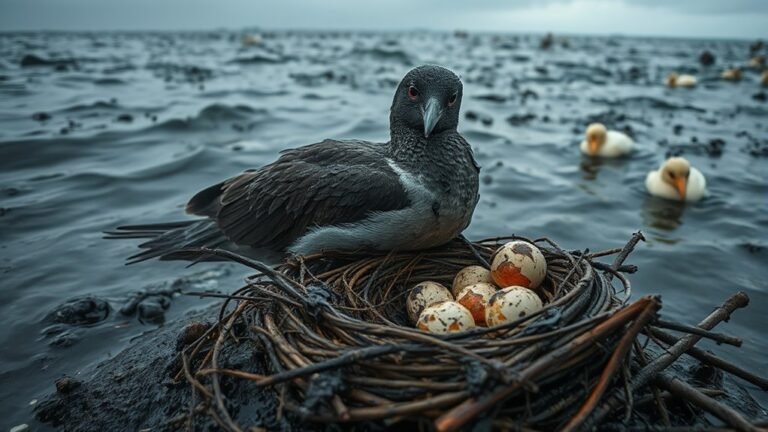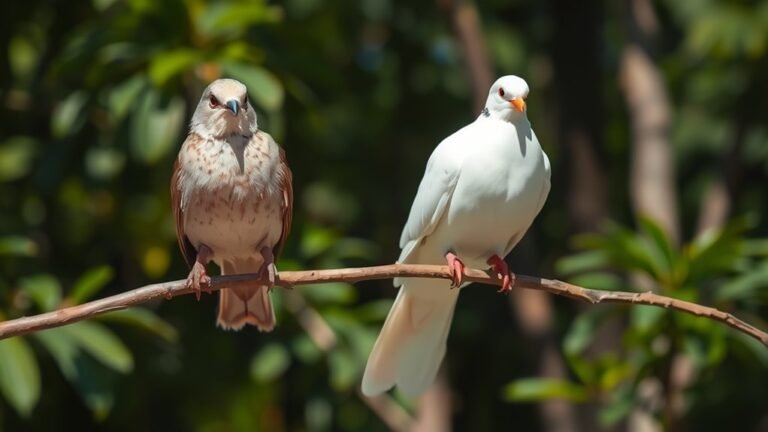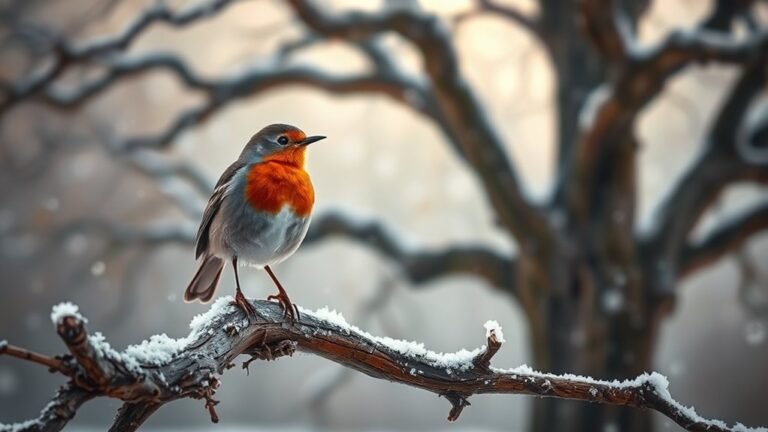A Guide to British Birds’ Eggs
Understanding British birds' eggs helps us appreciate bird diversity and conservation. Egg structure, size, and color vary between species. For example, Moorhen eggs look different from Song Thrush eggs. These differences assist in identifying species and reflect environmental factors. Nesting behaviors and strategies change with the seasons. How might these changes affect bird populations and the health of our environment?
Key Takeaways
- Bird eggs serve as protective vessels, providing nourishment and gas exchange for developing embryos, crucial for successful reproduction.
- Common British bird eggs include identifiable traits: Moorhen's pale blue, Blackbird's light blue, and Song Thrush's glossy olive-brown with spots.
- Raptor eggs are uniquely shaped and colored for camouflage, with females incubating and guarding them to regulate temperature.
- Habitat conservation and pollution control are vital for protecting bird eggs and ensuring breeding success in British avifauna.
- Resources for birdwatchers include field guides and apps for egg identification, enhancing engagement and awareness of local bird populations.
Understanding Birds' Eggs: An Overview

Birds' eggs are fascinating structures that serve important purposes for various species. Each egg protects and nourishes the developing embryo. The shell is made mostly of calcium carbonate, which gives it strength while allowing gas exchange through its porous surface.
The size and shape of eggs can differ widely among species, often reflecting their nesting habits and adaptations. Egg markings also help with camouflage and species identification. Different colors and patterns allow eggs to blend into their surroundings while showing parental lineage.
Understanding these features enhances your appreciation for the variety in British birds and their breeding strategies. This knowledge reveals the connection between structure, function, and survival.
The Role of Eggs in Bird Reproduction
Eggs are crucial for bird reproduction. They serve as the main environment where embryos develop. The structure of eggs includes protective membranes and special parts that help with nutrition and oxygen exchange. Each element, from the shell to the yolk, supports the survival of the growing embryo.
Birds adopt various strategies concerning egg size, shape, and color. These factors can affect how much care the parents provide and the success of the chicks. For example, smaller eggs may be laid in larger groups, whereas larger eggs usually result in stronger chicks.
Learning about these reproductive strategies and the chemistry of eggs can deepen your appreciation for birds and their lives.
Identifying Common British Bird Eggs

Have you ever wanted to identify the eggs of common British birds?
Each bird species lays unique eggs that you can recognize by their shape, color, and patterns.
Here is a simple guide:
- Moorhen: Their eggs are pale blue and slightly rounded.
- Song Thrush: These eggs have glossy, olive-brown shells with dark spots.
- Blackbird: The eggs are light blue and smooth.
- Robin: Their eggs are smaller, light blue, and lightly speckled.
Use this guide to help you identify the eggs of these birds easily.
Happy birdwatching!
The Characteristics of Sparrow Eggs
Identifying sparrow eggs can be interesting for bird lovers and nature fans.
Sparrow eggs are small, measuring about 1.1 to 1.4 centimeters long. Their colors vary, often appearing pale blue or off-white, and they usually have fine brown speckles. The eggs have a glossy texture, helping them stand out among other nesting materials.
Sparrow nests are often loosely built, using grasses and twigs. When you look for sparrow eggs, pay attention to these features.
Recognizing these details can make your birdwatching outings more enjoyable. It allows you to connect more closely with nature and appreciate sparrows better.
Thrush Eggs: Colors and Patterns

Thrush eggs have bright colors and unique patterns that attract birdwatchers and researchers. The colors of thrush eggs range from pale blue to greenish-brown.
Here are some important features to note:
- Ground Color: The background can be light, mottled, or speckled.
- Spots and Speckles: Look for dark brown or reddish spots, usually more concentrated at one end of the egg.
- Variation Among Species: Different thrush species have distinct patterns. For example, the Song Thrush has more noticeable markings compared to the Mist Thrush.
- Egg Size: Most eggs range from 2.5 to 3.2 cm in size.
Knowing about thrush egg patterns can help you appreciate these interesting birds even more. Enjoy observing their beautiful eggs!
Unique Features of Raptor Eggs
Raptor eggs have distinctive traits that set them apart from eggs of other birds. Their eggs show unique colors and patterns, which help them blend into their environment. This camouflage is crucial for protecting the eggs from predators.
During incubation, the female raptor stays close to the eggs, maintaining the right temperature and guarding them against threats. Raptor eggs are typically more pointed than those of other birds, which helps prevent them from rolling out of the nest.
These features illustrate the survival strategies raptors use to thrive in various habitats. Understanding these traits can deepen your appreciation for how these birds ensure their continued existence.
The Significance of Nesting Behavior
Nesting behavior is vital for bird reproduction. It impacts egg survival and chick growth. Here are key aspects of how nesting behavior helps birds thrive:
- Site Selection: Birds pick hidden spots to protect their eggs from predators.
- Nest Construction: They build strong nests using natural materials to shield eggs from the weather.
- Parental Care: Parents carefully brood and feed their chicks, boosting their chances of survival.
- Timing: Birds time their nesting with food availability to ensure enough resources for their young.
This straightforward approach to nesting ensures better outcomes for eggs and chicks alike.
How to Spot and Identify Nests
Identifying bird nests is an enjoyable activity for nature lovers and researchers. First, look at where the nest is located. Nests can be found in trees, bushes, or on the ground.
Next, observe the materials used to build the nest. Common materials include twigs, grass, feathers, and mud. Different bird species use different materials: blue tits often use moss and hair, while robins use mud and leaves.
Check for signs that a nest is being built, such as fallen twigs or feathers in the area. Take note of the size and shape of the nest. These features can help you identify the species.
Document what you find to improve your understanding of birds and their nesting habits. This connection with nature can be rewarding and enriching.
The Ethical Considerations of Nest Observations
Observing bird nests can improve your understanding of bird behavior. However, it's essential to consider ethical practices while doing so.
Here are simple guidelines for responsible observation:
- Keep your distance: Use binoculars to watch the birds without getting too close.
- Limit your time: Observe for a short time to reduce stress on the birds.
- Don't handle: Avoid touching eggs or chicks, as this can harm them or cause the parents to leave.
- Respect nesting areas: Be mindful of nesting seasons and stay away from areas marked as sensitive habitats.
Seasonal Changes in Egg Laying
As spring comes and temperatures rise, bird species in Britain start their breeding cycles, leading to changes in egg laying. Different species time their reproductive activities to match favorable conditions. This timing helps increase the survival rates of their young.
The start of egg laying varies by species and local factors. For example, early layers, like robins, may begin in March, while others, like thrushes, may wait until late spring. These patterns show how birds adapt to improve their reproductive success, responding to environmental signals such as daylight and temperature changes.
The Impact of Climate on Egg Development
Climate change significantly affects bird egg development. Here are key impacts:
- Temperature Extremes: High or low temperatures disrupt ideal conditions for incubation.
- Humidity Levels: Changes in humidity can alter the water loss needed for embryo development.
- Food Availability: Climate changes impact food sources for parent birds, affecting their reproductive success.
- Phenology Mismatch: Shifts in breeding times can cause eggs to hatch when food is scarce.
Monitoring these climate changes is crucial for protecting bird breeding success. Ensuring egg viability helps maintain healthy bird populations.
Understanding these impacts is vital for conservation efforts.
Conservation Efforts for Bird Species and Their Eggs
Addressing climate change is crucial for conserving bird species and their eggs. Effective strategies for egg protection rely on preserving habitats.
Creating protected areas helps maintain vital breeding grounds and supports ecosystem balance. Conservationists monitor bird populations and nesting sites to identify threats and take action.
Educating local communities encourages shared responsibility for bird conservation. Implementing laws to reduce pollution and habitat destruction strengthens these efforts.
Resources for Birdwatchers Interested in Eggs
Birdwatchers interested in observing eggs can find helpful resources that improve their knowledge and experience.
Here are some useful tools for bird egg identification and understanding nesting materials:
- Field Guides: These books provide clear illustrations and descriptions of eggs from British birds.
- Online Databases: Websites like the British Trust for Ornithology have tools for identifying eggs with ease.
- Birdwatching Apps: Mobile applications allow you to log observations and find identification resources quickly.
- Local Bird Clubs: Joining a club helps you meet others who share your interest and learn together through group events.
Using these resources can enrich your understanding of birds and their nesting habits.
Happy birdwatching!
Frequently Asked Questions
How Can I Legally Collect Bird Eggs in the UK?
To legally collect bird eggs in the UK, you need a specific license. This license follows bird conservation laws. Make sure you understand the rules. Only collect eggs under the approved conditions. This helps protect the environment and supports sustainability.
What Are the Most Endangered Bird Species With Unique Eggs?
Explore endangered bird species like the Kakapo and California Condor. These species have unique patterns on their eggs. Learning about these details helps you appreciate biodiversity. Conservation efforts are vital for preserving these rare birds.
Are There Any Records of Unusual Egg Colors?
There are records of unusual egg colors in various bird species. These eggs can show unique patterns such as speckles and stripes. These color variations help eggs blend into their environments, which can increase their chances of survival. Understanding these patterns can be interesting for bird watchers and scientists alike.
Do Bird Eggs Have a Smell?
Bird eggs can have a light smell. This smell changes based on how birds build their nests. The scents can warn predators or help draw parents to the eggs. Learning about these smells can give you insight into bird behavior.
How Do Temperatures Affect Egg Hatching Times?
Temperature affects how long it takes for eggs to hatch. Warmer temperatures make hatching occur faster. Cooler temperatures slow down the process. Understanding these effects helps you to appreciate what is needed for eggs to develop and hatch successfully.

Hello, I’m Emily Price, the founder of Birds Affection. As a passionate bird enthusiast and spiritual seeker, I’ve always been fascinated by the symbolic meanings and mystical connections between birds and our lives. On this website, I share my knowledge and insights on the spiritual significance of various bird species, exploring their roles as messengers, guides, and teachers. Through my writing, I aim to inspire and educate others on the profound wisdom and beauty that birds bring to our world. Join me on this journey as we delve into the enchanting realm of bird symbolism and discover the hidden meanings behind these magnificent creatures.







